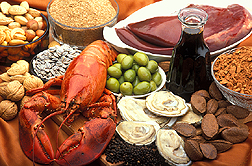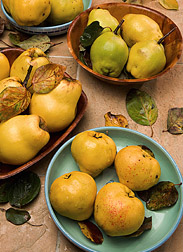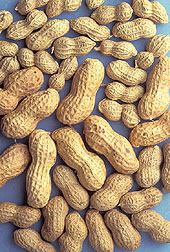| April 2007 |
|
|
Catfish Genetic Secrets Sought
America loves catfish!
In fact, it's the fourth most frequently eaten fish in the United States. And, it's the star of ongoing studies by ARS scientists with the Catfish Genetics Research Unit, Stoneville, Miss., and their university colleagues.
These investigators are intent on unlocking the secrets of the genetic makeup of catfish—the catfish genome. It’s about one-third the size of the human genome.
The findings can lead to superior, farm-raised catfish for tomorrow.
The scientists have already identified thousands of stretches of catfish genetic material, called DNA markers. The markers can be used in the hunt for genes that control valuable traits like larger fillets or improved resistance to common diseases.
For details, contact: Geoffrey C. Waldbieser, (662) 686-3593; USDA-ARS Catfish Genetics Research Unit, Stoneville, Miss.
Can Blueberries Fight "Bad" Cholesterol—and Colon Cancer?
Blueberries may help control cholesterol and battle colon cancer, preliminary studies with laboratory animals suggest. Hamsters that ate high-cholesterol chow, to which freeze-dried blueberry skins had been added, had nearly 20 percent less LDL cholesterol—the "bad" kind—in their blood (plasma) than did hamsters not fed the blueberry-spiked rations, an ARS-led study has shown.
Blueberry compounds such as resveratrol and pterostilbene may be key to the cholesterol-lowering effect, according to ARS scientists in the Natural Products Utilization Research Unit, Oxford, Miss.
Another collaborative study, this one directed by Rutgers University scientists, showed that nine laboratory rats fed rations to which a small amount of pterostilbene—40 parts per million—had been added developed 57 percent fewer induced colon lesions than nine other rats not given the compound (Clinical Cancer Research, volume 13, pages 350 to 355).
For details, contact: Agnes M. Rimando, (662) 915-1037; USDA-ARS Natural Products Utilization Research Laboratory, Oxford, Miss.
|
|
Copper's Heart-Healthy Effects Shown in Mice
Copper helped reverse unhealthy enlargement of the heart, called cardiac hypertrophy, in laboratory mice—an effect that scientists hope could also occur in humans afflicted with the condition. The work, reported recently in the Journal of Experimental Medicine (volume 204, pages 657 to 666), represents the first time this copper-related benefit has been shown.
An enlarged heart can be associated with shortness of breath, pain resulting from a decrease in blood supplied to the heart, and abnormal heart rhythms.
All mice in the study had enlarged hearts, but the condition reversed itself in the mice that were fed the equivalent of three times the amount of copper recommended for human health. Though high, the dose was nevertheless well below today's safe upper limit for copper, a nutrient essential for good health.
ARS scientists with the Grand Forks (N.D.) Human Nutrition Research Center collaborated in the study, which was led by colleagues at the University of Louisville Medical Center in Kentucky.
A handy list of foods that are good sources of copper is posted at:
https://ndb.nal.usda.gov/ndb/nutrients/
Scroll down to the line that reads "copper," then click on the "W" in the column—to the right—headed "sorted by nutrient content."
For details, contact: Gerald F. Combs, Jr., (701) 795-8456; USDA-ARS Grand Forks Human Nutrition Research Center, Grand Forks, N.D.
|
|
Peach-y Keen: Early Augustprince and Augustprince
Two new kinds of firm and luscious freestone peaches for southeastern U.S. orchards can help meet peach lovers' demand for the delectable fruit.
Early Augustprince ripens in mid- to late July. Augustprince follows, ripening in late July to early August.
Both new varieties yield large, round fruit that's nearly three inches in diameter. When ripe, the skin is 70 to 80 percent bright-red—with an attractive yellow background. The yellow flesh has some red if allowed to mature on the tree, and has a pleasing texture and flavor.
A decade of tests by ARS scientists with the Southeastern Fruit and Tree Nut Research Laboratory and by Clemson University researchers in South Carolina showed that Early Augustprince and Augustprince can outperform other currently planted commercial peach varieties that ripen at about the same time of year in the Southeast. Several fruit tree nurseries in Tennessee sell these new varieties.
For details, contact: William R. Okie, (478) 956-6405; USDA-ARS Southeastern Fruit and Tree Nut Research Laboratory, Byron, Ga.
|
|
Beneficial Bacteria Bash Listeria on Freshly Cut Fruit
Good-guy bacteria quelled Listeria monocytogenes, a food-poisoning microbe, in laboratory tests with freshly cut honeydew melon pieces artificially infected with the pathogen. Scientists found that a bacterium known as Gluconobacter asai—which occurs on apples and some other fruit—can work in tandem with what are known as bacteriophages to kill nearly all L. monocytogenes on the fruit. Bacteriophages are harmless to humans.
The work may lead to new options that enable food processors to meet the zero-tolerance standard for L. monocytogenes in processed, fresh-cut fruits and vegetables.
Researchers at the ARS Henry A. Wallace Beltsville (Md.) Agricultural Research Center and the ARS Appalachian Fruit Research Station, Kearneysville, W.Va., collaborated in the work with Intralytix, Inc., Baltimore, Md.
For details, contact: William S. Conway, (301) 504-6128; USDA-ARS Beltsville Agricultural Research Center, Beltsville, Md.; or Wojciech J. Janisiewicz, (304) 725-3451, ext. 358; USDA-ARS Appalachian Fruit Research Station, Kearneysville, W.Va.
|
|
Flavonoid Database Updated
Health-imparting plant compounds called flavonoids—like the cyanidin in cherries or catechins in tea—may reduce risk of certain diseases, studies have suggested. A newly updated, easy-to-use database from ARS nutrition researchers documents levels of 26 key flavonoids in about 400 fruits, vegetables and other foods.
Details on how to access the USDA Database for the Flavonoid Content of Selected Foods, Release 2.1 (2007), are posted on the World Wide Web at:
www.ars.usda.gov/nutrientdata/flav
Scientists with the ARS Beltsville (Md.) Human Nutrition Research Center used their own analyses of selected foods and beverages, along with data from nearly 100 new scientific papers on foods’ flavonoid content, to compile the update.
Key users of the database include researchers worldwide who are investigating the relation between flavonoids and reduced risk for cancer and other chronic diseases.
The database is a special supplement to the National Nutrient Database for Standard Reference, SR19, regarded as the nation's most authoritative source of food composition information.
For details, contact: David B. Haytowitz, (301) 504-0714; USDA-ARS Beltsville Human Nutrition Research Center, Beltsville, Md.
"Orange" Cauliflower Gene Eyed as Beta-Carotene Booster
Unique cauliflower, equipped naturally with a special gene that causes it to become orange instead of the familiar white, or even green, may hold the key to boosting the nutrients in other foods.
Scientists already know that a gene called Or, short for orange, cues the veggie to form beta-carotene—a compound that causes it to turn orange. Our bodies can use beta-carotene to form vitamin A, an essential nutrient. Most Americans don't get enough vitamin A from food, leading to researchers' interest in the Or gene as a key to creating beta-carotene-enriched plants for tomorrow.
Though investigators have known of the existence and role of the Or gene for many years, it wasn't until recently that ARS scientists and their Cornell University colleagues pinpointed and copied it. They're taking a detailed look at the gene's activity to learn exactly how it cues the plant to produce and store the color-imparting compound. They describe some of their newest discoveries in The Plant Cell (volume 18, pages 3594 to 3605).
For details, contact: Li Li, (607) 255-5708; USDA-ARS U.S. Plant, Soil and Nutrition Laboratory, Ithaca, N.Y.
|
|
Alturas Potato Soars to Idaho's Top Five
Versatile and tasty, Alturas potato is a top-quality spud from ARS researchers in Aberdeen, Idaho, and their co-investigators. First made available to growers about five years ago, Alturas today rates as the fifth most commonly planted potato in Idaho—the state that produces more potatoes than any other.
America's favorite veggie, potatoes provide fiber, vitamin C, potassium and other essential nutrients.
Alturas is suitable not only for processing into frozen potato products—or dehydrated foods such as instant potato flakes—but also for fresh-pack sale at your local supermarket (American Journal of Potato Research, volume 80, pages 295 to 301).
Researchers had put Alturas though about a decade of evaluations—including taste tests, trials in research fields and experiments at potato-processing plants—before determining it was ready for western U.S. farms.
For details, contact: Richard G. Novy, (208) 397-4181, ext. 111; USDA-ARS Small Grains and Potato Germplasm Research Unit, Aberdeen, Idaho
America's Quince Collection Grows
Quince trees from around the planet are safeguarded in America's official quince collection, located at the ARS National Clonal Germplasm Repository in Corvallis, Ore. A bright-yellow, fuzzy cousin of pears and apples, quince is worth conserving not only for its own sake, but also for that of pears. That's because quince provides a "dwarfing" rootstock to which pears can be grafted, forming easy-to-manage, early-fruiting pear trees.
Trees from Armenia and the Republic of Georgia have recently been added to the collection, the largest publicly owned assortment of quinces in the United States. What's more, studies of the characteristics and genetic makeup of these trees may reveal prized traits such as cold-hardiness, or resistance to the microbe that causes fire blight disease. Those traits could be bred into other quinces to create superb new trees for tomorrow.
For details, contact: Joseph D. Postman, (541) 738-4220; USDA-ARS National Clonal Germplasm Repository, Corvallis, Ore.
|
|
Soy's Intriguing Saponins
Cancer-preventing properties of saponins—natural compounds found in soybeans and a variety of other plants—are now easier to study. That's thanks to a new technique to more readily extract and purify them.
ARS scientists at the agency's National Center for Agricultural Utilization Research, Peoria, Ill., and colleagues at the University of the Incarnate Word, San Antonio, Texas, did the work (Journal of Agricultural and Food Chemistry, volume 54, pages 2035 to 2044).
Saponins' cancer-fighting effects have been shown in studies such as a 2005 investigation in which ARS and University of Illinois scientists found that exposing cancerous human colon cells to saponins reduced the cells' growth by 27 to 68 percent (Carcinogenesis, volume 26, pages 159 to 167).
For details, contact: Mark A. Berhow, (309) 681-6347; USDA-ARS National Center for Agricultural Utilization Research, Peoria, Ill.
Tomorrow's Onions: Even More Nutritious!
Sweet-yet-sharp onions are definitely palate pleasers, but their stronger flavored cousins pack more of a nutritional punch. ARS plant geneticists are learning more about onions' nutrient-imparting genes so that tomorrow's most popular types might provide more nutrients—along with the familiar flavors and textures.
The research focuses on genes responsible for three different groups of health-enhancing compounds: blood-thinning thiosulfinates, fiber-rich fructans and flavonoids such as quercetin that help protect the body against oxidative damage.
Working in cooperation with scientists in New Zealand and Japan, ARS scientists based at the Vegetable Crops Research Unit, Madison, Wis., already have found several genes of interest, including one that helps onions accumulate fructans (Theoretical and Applied Genetics, volume 112, pages 958 to 967). The more fructans there are, the more heart-healthy thiosulfinates there'll be, too.
For details, contact: Michael J. Havey, (608) 262-1830; USDA-ARS Vegetable Crops Research Unit, Madison, Wis.
|
|
Peanut Flour Offers Protein, Texture and Flavor
Nutrition bars, salad dressings, sauces—and more—all benefit from the flavors, textures and proteins provided by peanut flour. Now, tests by ARS scientists have shown that lower-fat peanut flours can thicken more effectively than higher-fat ones.
The researchers, who work at the Market Quality and Handling Research Unit, Raleigh, N.C., report this and other new findings about the versatile flour in the Journal of Texture Studies (volume 38, pages 253 to 272).
For details, contact: Jack P. Davis, (919) 515-6312; USDA-ARS Market Quality and Handling Research Unit, Raleigh, N.C.













